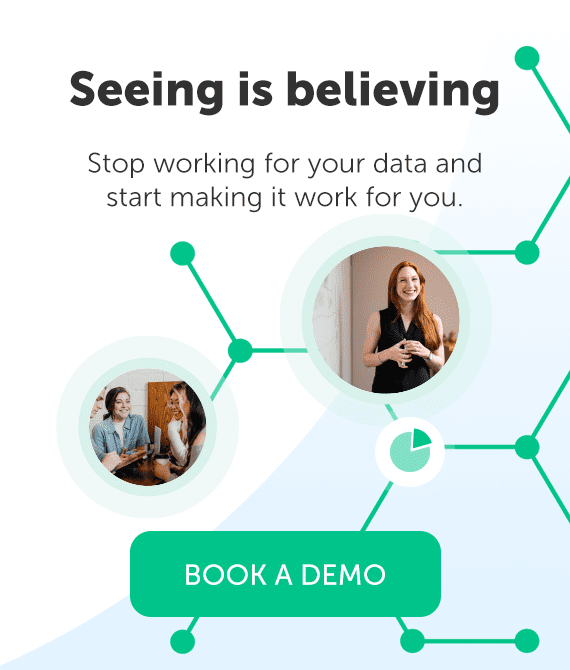Every firm wants to be “client-centric,” but what does that actually look like in practice? If surveys and anecdotal updates reflect the past, how can you measure what’s happening now and spot declining engagement before it affects retention?
Below, we explore how customer relationship scores give firms a more objective, data-driven view of relationship strength, turning everyday client interactions into measurable indicators of account health, predictive churn analytics, and growth potential.
The flaw in traditional metrics like NPS
Net Promoter Score (NPS) has long been the default shorthand for client satisfaction. It’s simple, familiar, and easy to benchmark. But in professional services, where relationships are complex and collective, it rarely captures what’s actually happening inside an account. NPS reflects one person’s opinion at a single point in time, which makes it a subjective, lagging indicator.
Because it’s rooted in perception rather than behavior, one stakeholder’s score can swing dramatically after a single interaction, while others who play a key role in the relationship may never have a say at all. This narrow lens leaves the door open to bias and timing effects, especially when the client relationship spans multiple partners, teams, or offices.
The biggest flaw is that NPS reacts instead of predicts. It won’t tell you when a key contact has stopped engaging with your team, and by the time the score reflects the change, the relationship may already be slipping below healthy levels. At that point, you’re managing recovery, not risk.
Recent research from Reuters underscores this shift: firms that practice active relationship management, i.e., staying connected between matters instead of waiting for feedback, are better positioned to prevent client attrition before it starts.
Defining the customer relationship score
A customer relationship score offers a dynamic, objective view of relationship health, grounded in how your firm actually interacts with clients. Instead of relying on surveys or anecdotes, it draws on real engagement data by analyzing the signals that define relationship strength: who you talk to, how often, and how recently.
Because it’s grounded in actual behavior, a customer relationship score acts as a leading indicator for client retention and growth. By incorporating elements of predictive churn analytics, it helps firms detect subtle shifts in engagement before they show up in client activity or revenue. With a clear, data-backed account health score, you can prioritize outreach, reinforce strong relationships, and intervene early when engagement starts to fade.
This kind of data-driven approach is becoming a competitive differentiator across professional services. For example, a CPA.com survey of accounting advisory firms found that those investing in relationship analytics and automation are seeing higher retention and stronger advisory growth margins than peers relying on traditional client feedback alone.
How is a relationship score calculated automatically?
A customer relationship score is calculated automatically using the communication data your firm already generates every day.
The data inputs
The relationship score is built from the everyday client interactions already happening across your firm, turning that activity into a clear, data-driven view of account health. It looks at the frequency, recency, and depth of communication, factoring in both volume and quality indicators: Are your teams engaging regularly? Are those touchpoints happening at senior levels, like the C-suite or key decision-makers? Is engagement trending upward or dropping below healthy levels?
Every email, meeting, and touchpoint contributes to a measurable view of client engagement. Aggregating this data surfaces trends in relationship activity and helps identify emerging risks or opportunities across accounts.
The key factors
Platforms like Introhive apply relationship intelligence to engagement data from emails and meetings, looking at communication frequency and recency, response time, and the breadth/depth of connections across an account, including executive stakeholders. The goal is to surface patterns that indicate relationship strength, momentum, and risk so teams can act early. This behavioral insight forms the foundation of client retention analytics, enabling firms to predict shifts within engagement before they impact revenue.
Together, these signals feed into a single, dynamic view of account health that updates automatically. It gives your firm clear visibility into where relationships are expanding, where coverage is thin, and where proactive engagement can deepen relationships and support long-term growth.
3 ways a relationship score drives business growth
With a data-backed view of relationship health, your firm can focus resources where you know they’ll have the greatest impact on retention and growth. Powered by real-time engagement data, a customer relationship score brings the principles of client retention analytics into everyday account management by turning insight into action. It helps teams strengthen client relationships, improve profitability, and build long-term account health.
1. It acts as a proactive churn predictor
A declining relationship score is one of the most reliable indicators of client risk. By monitoring shifts in communication patterns and engagement intensity, your firm can spot when a relationship is beginning to cool, often weeks or months before a client voices dissatisfaction. This kind of forward-looking insight gives partners and client teams time to re-engage key stakeholders, strengthen connections, and protect long-term revenue before issues escalate.
2. It identifies your strongest advocates
High relationship scores reveal more than healthy accounts – they point to the clients who consistently champion your firm. These relationships show sustained engagement, senior-level involvement, and a pattern of collaboration that extends across practice areas. By applying relationship analytics, firms can pinpoint where advocacy is strongest and convert that goodwill into referrals, testimonials, and new opportunities for growth.
3. It focuses your team’s efforts
An updated account health score helps teams prioritize their time and attention on the relationships that matter most. When relationship data shows which accounts are thriving and which are at risk, your partners and client development leaders can allocate time and resources where they’ll make the biggest difference. That means less guesswork, more proactive outreach, and a sharper focus on growing high-value, high-potential relationships.
The platform that powers the score
Manually calculating a customer relationship score wouldn’t just be tedious, it would be unmanageable. Picture the spreadsheet it would take: tens of thousands of rows tracking every single email and meeting between your firm and each client contact. Each line would need dates, senders, recipients, subjects, and seniority tags. You’d have to log who initiated the exchange, how quickly they replied, and when the next follow-up happened. Even for one key client, that workbook could run to dozens of tabs and still fall out of date before the week’s over. At scale, maintaining it would be a full-time job for a team of analysts.
That’s why top firms use relationship intelligence platforms like Introhive. Introhive automates what would otherwise be an impossible manual process by passively capturing every interaction, enriching data in real time, and synthesizing it into a living, continuously updated account health score. Its AI-powered engine analyzes communication frequency, recency, response time, relationship reach, and engagement strength to surface not just what’s happening now, but where it’s headed – spotting early declines in client engagement before they translate into revenue loss. With built-in alerts (via features like Signals) and instant access through Ask Introhive, your team gets proactive, predictive insight rather than reactive hindsight.
With automation at its core, Introhive gives your teams accurate, objective, and actionable relationship data. The outcome is clarity at scale: a firm-wide view of relationship strength, clear visibility over engagement risk and opportunity, and the confidence to focus attention where it matters most. Ready to turn that clarity into action?See how leading firms use Introhive to quantify relationship strength and act on it.





